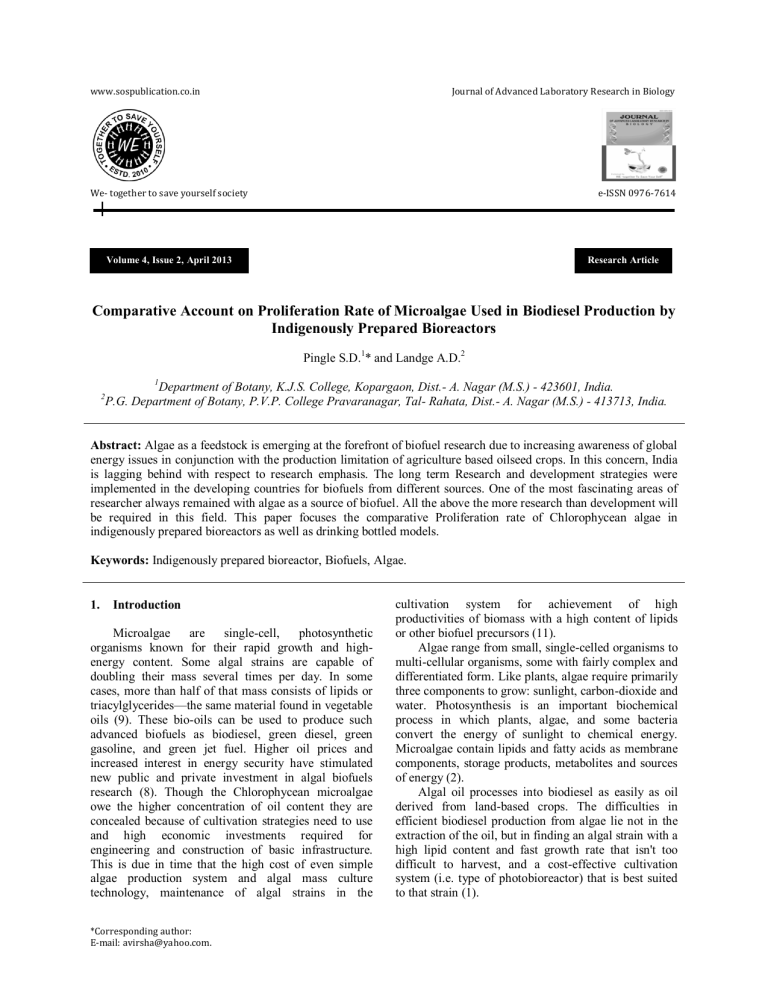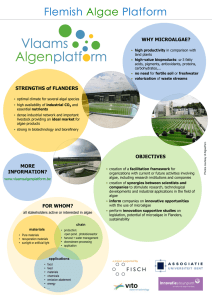Comparative Account on Proliferation Rate of Microalgae Used in Biodiesel Production by Indigenously Prepared Bioreactors
advertisement

www.sospublication.co.in Journal of Advanced Laboratory Research in Biology We- together to save yourself society e-ISSN 0976-7614 Volume 4, Issue 2, April 2013 Research Article Comparative Account on Proliferation Rate of Microalgae Used in Biodiesel Production by Indigenously Prepared Bioreactors Pingle S.D.1* and Landge A.D.2 1 2 Department of Botany, K.J.S. College, Kopargaon, Dist.- A. Nagar (M.S.) - 423601, India. P.G. Department of Botany, P.V.P. College Pravaranagar, Tal- Rahata, Dist.- A. Nagar (M.S.) - 413713, India. Abstract: Algae as a feedstock is emerging at the forefront of biofuel research due to increasing awareness of global energy issues in conjunction with the production limitation of agriculture based oilseed crops. In this concern, India is lagging behind with respect to research emphasis. The long term Research and development strategies were implemented in the developing countries for biofuels from different sources. One of the most fascinating areas of researcher always remained with algae as a source of biofuel. All the above the more research than development will be required in this field. This paper focuses the comparative Proliferation rate of Chlorophycean algae in indigenously prepared bioreactors as well as drinking bottled models. Keywords: Indigenously prepared bioreactor, Biofuels, Algae. 1. Introduction Microalgae are single-cell, photosynthetic organisms known for their rapid growth and highenergy content. Some algal strains are capable of doubling their mass several times per day. In some cases, more than half of that mass consists of lipids or triacylglycerides—the same material found in vegetable oils (9). These bio-oils can be used to produce such advanced biofuels as biodiesel, green diesel, green gasoline, and green jet fuel. Higher oil prices and increased interest in energy security have stimulated new public and private investment in algal biofuels research (8). Though the Chlorophycean microalgae owe the higher concentration of oil content they are concealed because of cultivation strategies need to use and high economic investments required for engineering and construction of basic infrastructure. This is due in time that the high cost of even simple algae production system and algal mass culture technology, maintenance of algal strains in the *Corresponding author: E-mail: avirsha@yahoo.com. cultivation system for achievement of high productivities of biomass with a high content of lipids or other biofuel precursors (11). Algae range from small, single-celled organisms to multi-cellular organisms, some with fairly complex and differentiated form. Like plants, algae require primarily three components to grow: sunlight, carbon-dioxide and water. Photosynthesis is an important biochemical process in which plants, algae, and some bacteria convert the energy of sunlight to chemical energy. Microalgae contain lipids and fatty acids as membrane components, storage products, metabolites and sources of energy (2). Algal oil processes into biodiesel as easily as oil derived from land-based crops. The difficulties in efficient biodiesel production from algae lie not in the extraction of the oil, but in finding an algal strain with a high lipid content and fast growth rate that isn't too difficult to harvest, and a cost-effective cultivation system (i.e. type of photobioreactor) that is best suited to that strain (1). Proliferation Rate of Microalgae Used in Biodiesel Production Microalgae have much faster growth rates than terrestrial crops. The per unit area yield of oil from algae is estimated to be from between 5,000 to 20,000 gallons (18,927 to 75,708 litres) per acre, per year; this is 7 to 31 times greater than the next best crop, palm oil (635 gallons or 2,404 litres) (11). The production of algae to harvest oil for biodiesel has not yet been undertaken on a commercial scale, but feasibility studies have been conducted to arrive at the above yield estimate. In addition to its projected high yield, algaculture — unlike crop-based biofuels do not entail a decrease in food production, since it requires neither farmland. Many companies are pursuing the development of algae bioreactors for various purposes – including biodiesel production and CO2 capturing (10). Producing biodiesel from algae has been touted as the most efficient way to make biodiesel fuel. The main advantages of deriving biodiesel from algae oil include: rapid growth rates, a high per acre yield (7), algae biofuel contains no sulphur, algae biofuel is non-toxic, algae biofuel is highly biodegradable, and algae consume carbon dioxide as they grow, so they could be used to capture CO2 from power stations and other industrial plant that would otherwise go into the atmosphere (4). Research into algae for the mass production of oil is mainly focused on microalgae. The preference towards microalgae is due largely to its less complex structure, fast growth rate, and high oil content. Attempts were made in this paper to show the rate of multiplication of two microalgae, Chlorella vulgaris and Scenedesmus dimorphus. 2. Material and method 2.1 Collection of algal sample The Samples of microalgae were collected from ponds, puddles, dams and rivers of Ahmednagar district with the help of plankton net made up of bolting silk (No. 25; mesh size 55 micron). The samples were then transferred to narrow mouthed plastic bottles and brought to the laboratory. 2.2 Isolation of algae The collected samples were brought to the laboratory and isolated by the serial dilution method followed by plating. Media used for isolation and to maintain the culture were Bold Basal media, modified Pingle and Landge Chu 13 media (5) and incubated at 25 ± 10C under 1.2 ± 0.2 Klux light intensity with 16:8 hrs light photoperiod. 2.3 Studies of multiplication rate of microalgae The growth rate of both algae Chlorella vulgaris and Dunaliella salina were studied by growing algae in Erlenmeyer flask (250ml), indigenously prepared photobioreactor with the help of cleaned electricity tube bars and empty drinking water bottles (1 liter). As shown in photo plate 1 incubated at 25 ± 10C under 1.2 ± 0.2 Klux light intensity with 16:8 hrs light photoperiod. Artificial air was provided with the help of bower for the indigenously prepared model. The experiment was conducted in triplicates. 2.4 Measurement of growth of the algae The rate of growth was calculated after 15 days with the help of proliferation rate (Huang et al., 2002): = ( t − 0) . Where, ODt: Terminal optical density; OD0: Initial optical density; T: Days Optical density was measured by spectrophotometer using 680nm wavelengths (6) each sample was thoroughly swirled before taking the measurement. The calculated value was recorded in Table 1. 3. Results As shown in Table 1 the proliferation rate of Chlorella and Scenedesmus had shown significant values in indigenously prepared photobioreactor and bottled bioreactors. In Erlenmeyer flask, the proliferation rate of Chlorella was 0.031 which is not significant whereas it shows significant values in indigenously prepared electricity tube bioreactors, 0.098 and water bottle bioreactor 0.176. Same were observations with Scenedesmus it had a non-significant proliferation rate in Erlenmeyer flask i.e. 0.042, whereas significant in indigenously prepared electricity tube bioreactors, 0.0112 and water bottle bioreactor 0.190. In comparison with the proliferation rate of both algae, Scenedesmus shows more significant growth over Chlorella at culture condition in modified Chu 13 liquid medium. Apart from this, the Chu 13 medium proved good for the growth and isolation of the unicellular Chlorophycean algae. Table 1. Effect of different cultivation conditions for biomass multiplication on the growth of algae (Proliferation rate). Sr. No. Name of algae 1 2 Chlorella vulgaris Scenedesmus dimorphus Erlenmeyer flask 0.031 0.042 Indigenous Bioreactor Drinking water Bottles Rate of proliferation (K) 0.098* 0.176* 0.112* 0.190* *Significance observed on the proliferation rate in different growth condition (p ≤ 0.05). J. Adv. Lab. Res. Biol. 61 Proliferation Rate of Microalgae Used in Biodiesel Production 4. Pingle and Landge Discussion The growth rate observed in the different models will prove a concrete step towards the production and increase in the yield of biomass for oil production. The proliferation rate shown by both algae in the bioreactor was due to availability of space and facility of aeration to the algae. In the bioreactor prepared from the drinking water exchange of gas was easier as compared to tube bioreactor. Also, the byproduct of photosynthesis i.e. oxygen gets escaped easily from this bioreactor. Availability of CO2 was easy due to continuous circulation of air through media. Assuming the technology can be developed, become worthwhile; perhaps even a significant, contribution to the goal of renewable energy production, in particular of transportation fuels. Again, the resource potential requires further studies. The different algae should be checked for the maximum proliferation rate and standardized. [4]. Reference [9]. [1]. Benemann, J.R. (2008). Opportunities & Challenges in Algae Biofuels Production. Position paper available on www.futureenergyevents.com/algae/. [2]. Goldman, J.C. (1979). Outdoor algal mass cultures –II. Photosynthetic yield limitation. Water Res., 13:119-136. [3]. Xianghu, H., Changling, L., Chuwu, L., Duanquan, Z. (2002). Studies on the ecological J. Adv. Lab. Res. Biol. [5]. [6]. [7]. [8]. [10]. [11]. factors of Oocystis borgei. Journal of Zhanjiang ocean University, 22(3): 8-12. Huntley, M., Redalje, D. (2006). CO2 mitigation and renewable oil from photosynthetic microbes: a new appraisal. Mitig. Adap. Strateg. Glob. Change, 12(4):573-608. Largeau, C., Casadevall, E., Berkaloff, C. and Dhamelincourt, P. (1980). Sites of accumulation and composition of hydrocarbon in Botryococcus braunii. Phytochemistry, 19(6):1043-1051. Lee, S.J., Kim, S.-B., Kim, J.-E., Kwon, G.-S., Yoon, B.-D., Oh, H.-M. (1998). Effects of harvesting method and growth stage on the flocculation of the green alga Botryococcus braunii. Letters in Applied Microbiology, 27(1):14-18. Leonard Wagner (2007). Biodiesel from algae oil. Research report from Mora associates Ltd. leonard@moraassociates.com. National Biodiesel Board USA (2002). Available in www.bidiesel.org/. Pingle, S.D. and A.D. Landge, (2010). Lipid content of submicroscopic freshwater algae for biodiesel production as renewable energy. Flora and Fauna, Special Issue, 2010: 107-108. Treehugger, (2006). Veridium Patents Yellowstone Algae-Fed Bioreactor to Capture Ethanol Plant CO2 Emissions. Published by Treehugger. Retrieved on July 5th, 2007 from http://www.treehugger.com/files/2006/03/veridian _corp_e.php. Chisti, Y. (2007). Biodiesel from microalgae. Biotechnol. Advances, 25: 294-306. 62






